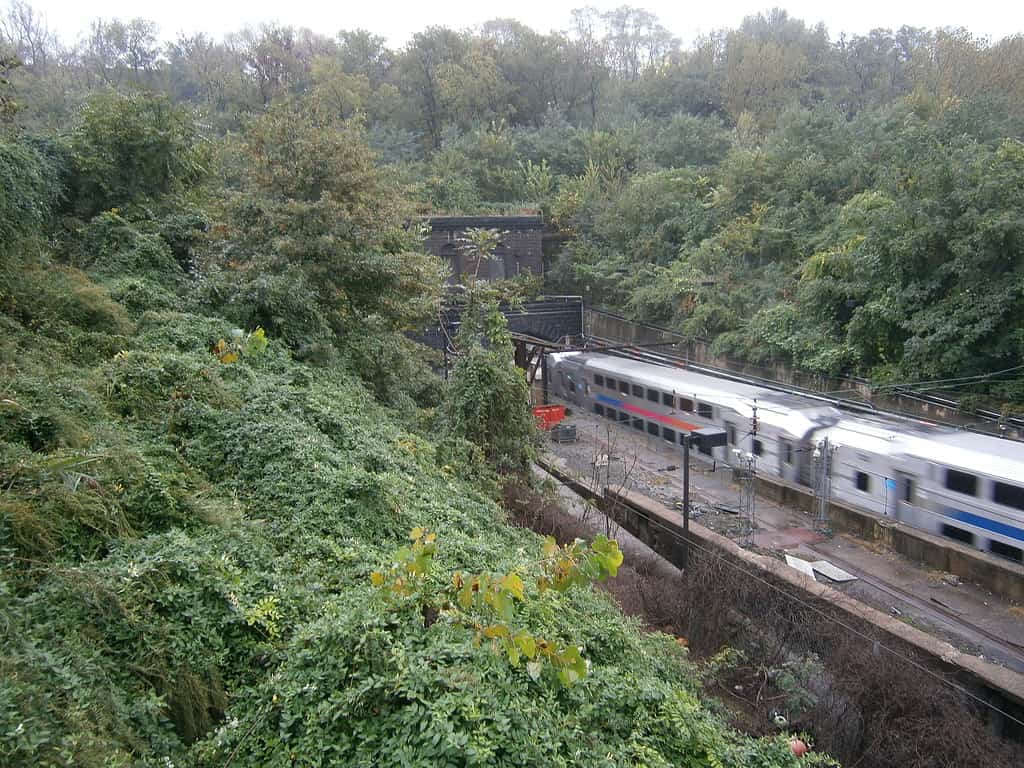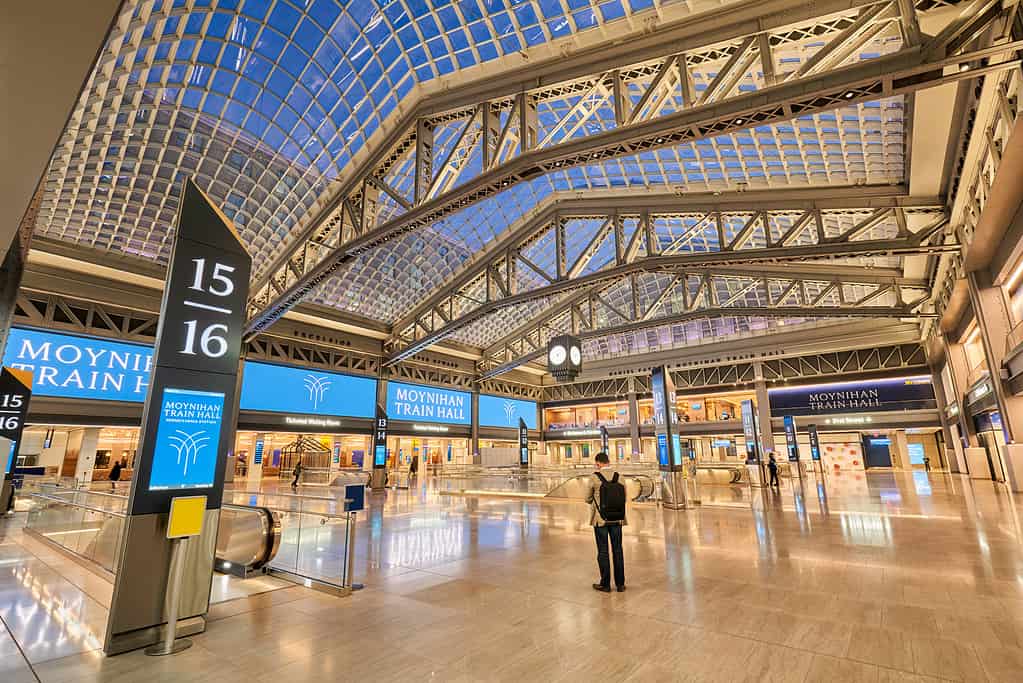New Jersey has a handful of tunnels, most of which operate as railroad tunnels for trains carrying passengers or freight. The state also possesses its fair share of tunnels that can accommodate automobiles. These tunnels range in size from the relatively small tunnel on Arch Street in High Bridge to the Lincoln Tunnel, which connects Weehawken, New Jersey, to Midtown Manhattan in New York City. That said, what is the longest tunnel in New Jersey?
At over 2.5 miles long, the North River Tunnel ranks as the longest tunnel in New Jersey. In this article, we’ll dive into the history of the North River Tunnel. We’ll also discuss how it was built, its location, and the current state of the tunnel. Finally, we’ll take a look at the wildlife that you can find around the tunnel. Keep reading to discover the longest tunnel in New Jersey.
History of the North River Tunnels

The North River Tunnel is the longest tunnel in New Jersey.
©Hudconja, CC BY-SA 3.0 via Wikimedia Commons – License
New York City’s rapid growth in the 19th century led to calls to improve transportation to and from the city. As early as 1860, authorities and residents alike started to toy with the notion of extending rail service into New York. At that time, no rail service existed over the Hudson River or the East River. Passengers wishing to cross between New Jersey and New York were forced to transfer to a ferry, a much slower and less effective means of transporting large numbers of passengers.
By 1871, the Pennsylvania Railroad (PRR) controlled most of the railroad service in New Jersey. Over the next few decades, it sought to extend its control into New York City through the construction of a railroad connecting New Jersey to New York City. After several failed attempts and decades of planning, the PRR created a few subsidiaries to manage the project. The Pennsylvania, New Jersey, and New York Railroad set out to handle construction on what turned into the North River Tunnel. After some pushback from the New York City Board of Rapid Transit Commissioners over jurisdiction, as well as some objections from possible competitors, the New York City Board of Alderman approved the project in December 1902. Upon completion, the railroad tunnel would connect Weehawken, New Jersey at Bergen Hill with the newly built Pennsylvania Station in Manhattan.
Construction of the North River Tunnels
In reality, the North River Tunnel consists not of one tunnel but two. Construction on these tunnels, collectively called the North River Tunnels, began in 1902. Led by Chief Engineer Charles M. Jacobs, the O’Rourke Engineering Construction Company undertook the task of building the tunnels.
The first step of the project consisted of daggering two large shafts, one on each side of the Hudson River. The shaft on the eastern shore was located just a few blocks from 11th Avenue in Manhattan, while the shaft on the western shore came out in Weehawken, New Jersey. Once the shafts measured around 76 feet deep, construction on the tunnels proper began. Engineers built the tunnel by drilling and blasting the rock under the river and reinforcing the tunnels with metal shields. When they reached mud sections, they drove forward using compressed air to push the shields forward and excavate the tunnels. With the tunnels complete, they were then lined with 22-ton cast-iron rings bolted together and surrounded with concrete.
Construction on the North River Tunnels finished in 1908. However, the tunnels did not open for railroad traffic until 1910. From one end to the other, the tunnels measure approximately 14,575 feet long. At the lowest point near Bergen Hill, the tunnels measure over 175 feet below the surface.
Where Are the North River Tunnels Located?
The North River Tunnels run under the Hudson River and connect New Jersey to New York.
The New Jersey (west) portals of the tunnels lie in North Bergen near the western edge of the New Jersey Palisades. From there, the tunnels run under the townships of North Bergen, Union City, and Weehawken.
Meanwhile, the New York (east) portals exit onto the east side of 10th Avenue at 32nd Street in Manhattan, New York City. From there, trains existing tunnels into New York fan out onto one of 21 different tracks that feed into Penn Station.
The North River Tunnels Today

More than 200,000 passengers ride the North River Tunnels into Penn Station each weekday.
©iStock.com/Francois-roux
The North River Tunnels belong to the Northeast Corridor railroad line. This rail line serves many of the metros in the northeastern corner of the United States, including Baltimore, Boston, New York City, Providence, Trenton, and Washington, D.C. The tunnels support Amtrak as well as New Jersey Transit passenger trains.
At maximum capacity, the North River Tunnels can facilitate 24 crossings each way per hour. Each weekday, NJ Transit and Amtrak operate around 425 trains through the tunnels carrying approximately 200,000 passengers.
Starting in the 1990s, plans began to circulate that proposed building new tunnels under the Hudson River to improve traffic flow into and out of New York City. These proposals frequently cited the deteriorating conditions of the North River Tunnels as a major factor for constructing new tunnels.
In October 2012, Hurricane Sandy flooded both of the North River Tunnels. The flooding severely damaged both tunnels and caused delays in passenger rail transit in the tunnels that persist to this day. In 2021, the Gateway Project was approved. This project aims to build two new tunnels under the Hudson River to expand rail transit. The tunnels are expected to be completed by 2035, at which point the existing North River Tunnels will be rehabilitated.
Wildlife Around the North River Tunnels

Just above the North River Tunnels swim large fish like the Atlantic
sturgeon
.
©David A. Litman/Shutterstock.com
Due to the frequent passing of trains, the North River Tunnels likely do not house a significant animal population (aside from insects and rats). That said, you can find a wide variety of animals in the Hudson River above the tunnels as well as just outside the New Jersey and New York City portals.
The Hudson River supports a diverse ecosystem of marine creatures, including crabs, fish, and barnacles. Some animals you can find at the bottom of the Hudson River include Atlantic sturgeons, glass eels, and round gobies.
On the New Jersey side of the tunnels, you can expect to find deer, black bears, bobcats, beavers, and foxes. Meanwhile, on the New York side of the tunnels, you can find squirrels, raccoons, and a wide variety of birds.
Where are the North River Tunnels Located on a Map?
Connecting Weehawken, New Jersey, to Pennsylvania Station in Manhattan, New York City, the North River Tunnels serve as a vital passage for Amtrak and New Jersey Transit passenger lines beneath the Hudson River. This pair of rail tunnels facilitates seamless transportation between the two locations, enabling efficient travel for commuters and travelers alike.
Here are the North River Tunnels on a map:
The photo featured at the top of this post is © littlenySTOCK/Shutterstock.com
Thank you for reading! Have some feedback for us? Contact the AZ Animals editorial team.






